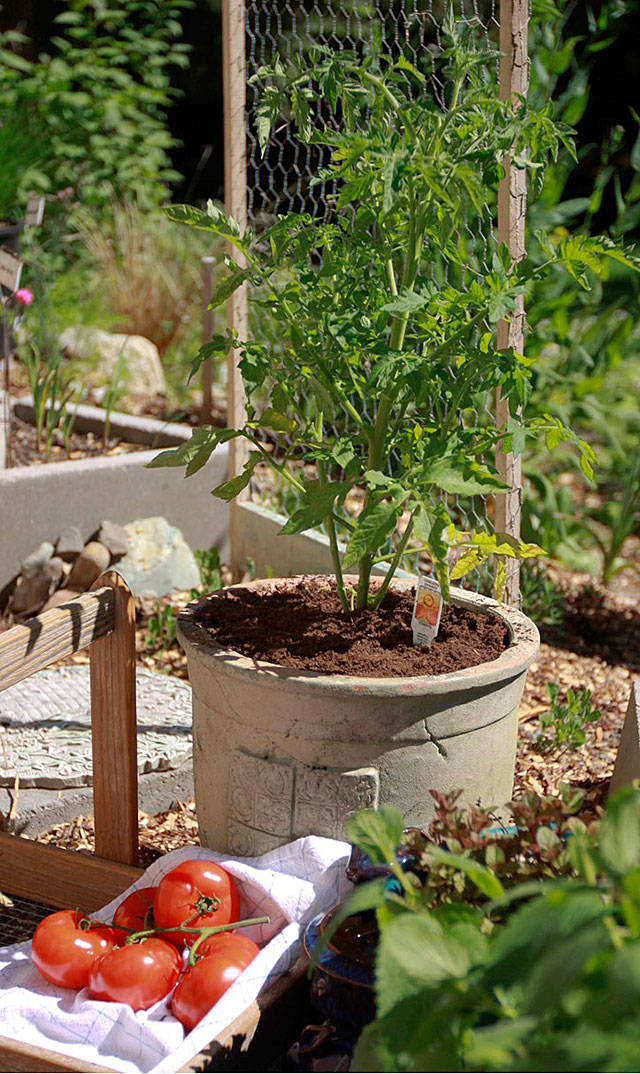Your tomato plants are in the ground, looking healthy, and it is now time for “tomato maintenance”! With a little bit of basic care, you can increase your yield of tasty home grown tomatoes.
Watering and mulching
Tomatoes prefer to be watered deeply on a regular schedule. Inconsistent watering can cause fruit to crack. Water plants thoroughly, soaking the soil to a depth of about six inches. Frequency depends on soil type and weather. Create a reservoir around the plant to collect the water and allow it to slowly soak into the soil or water with a soaker hose. Keeping the leaves dry decreases the occurrence of disease. Overhead watering wets the leaves and contributes to fungal problems.
Many home gardeners are using open-ended plastic tunnels, called high tunnels, to protect plant leaves from rain and misty/foggy conditions. Apply mulch around plants to help maintain a consistent moisture level and discourage weeds.
Feeding
In the second month after planting or when plants begin to flower, apply 10-10-10 slow-release organic fertilizer, then water well. Apply diluted fish emulsion every two to three weeks. If leaves begin to yellow, apply a small amount of low nitrogen fertilizer; too much nitrogen encourages vegetative growth with very little fruit.
Staking and cages
Stake and/or put a cage around each plant when it is small. Use material sturdy enough to support the mature plant. Staking or caging keeps the plant off of the moist soil and improves air circulation and access to fruit.
Pruning
A properly pruned and supported tomato plant will produce earlier and larger fruit and will be less likely to have cracked, diseased fruit. Plants with very dense foliage will produce fewer and smaller tomatoes. Pruning allows leaves to dry faster, decreasing the occurrence of fungal disease. Tomato plants are aggressive growers and will produce suckers or side shoots between a leaf and the main stem. Remove the suckers by pinching them off when they are small.
Blossoms and fruit that are too small to reach maturity before temperatures begin to cool in late summer should be removed to direct energy into the ripening fruit.
Avoiding late blight
Late blight (Phytophthora infestans) is a serious threat to tomatoes and can kill plants in only a few days. Although it is called “late” blight, it can occur any time conditions are cool and wet. Prevention is better than treatment. Provide shelter to keep plant leaves dry. Ensure adequate air circulation between plants.
The disease appears as brown to black spots on the leaves and stems and as grayish areas on green tomatoes. As late blight progresses, the underside of leaves appear gray and dead, and may show a margin of white cottony material. Spots on the fruit turn brown and wrinkled. The blotches tend to occur where moisture collects. Older leaves close to the ground are usually the first to show signs of blight. The late blight then progresses upward.
If you find these symptoms, remove and destroy the affected leaves. If disease has reached the fruit, the entire plant should be removed and destroyed. Do not compost the plant or fruit. Late blight is soil-borne and thrives in cool wet weather (temperatures between 50-70 degrees F, combined with rain, fog and heavy dew).
In mild climates the late blight can overwinter in diseased potato tubers and contaminated tomato fruit left in the soil. Late blight can be spread from the soil by wind, rain, insect and human contact.
Judy English is a Washington State University-Certified, Clallam County Master Gardener.



